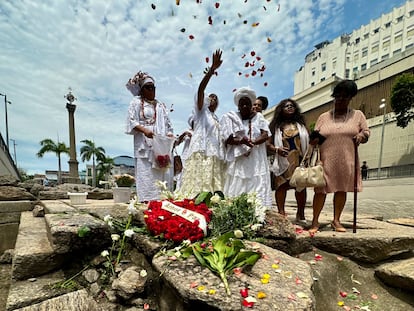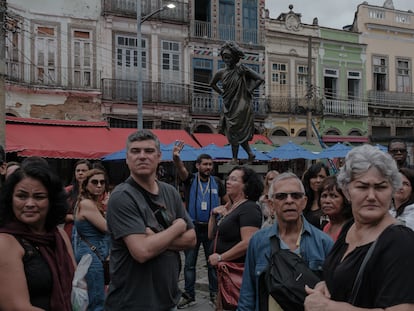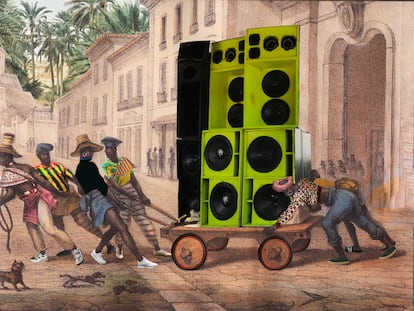Rio de Janeiro commemorates enslaved Africans at the wharf where a million disembarked
City officials inaugurated the renovated Cais de Valongo, a UNESCO World Heritage Site since 2017

During the preparations for the 2016 Olympic Games in Rio de Janeiro, workers made an unexpected discovery in a square in the port area. They found large stone slabs, shells, amulets and personal objects. Archaeologists later confirmed that these artifacts were from the Cais do Valongo, the wharf where over a million enslaved Africans arrived in Brazil. In 2017, UNESCO named it a world cultural heritage site, acknowledging the significance it holds for the ancestors of Black Brazilians.
In years that followed, the site witnessed a steady increase in visitors, yet remained neglected with minimal signage and insufficient lighting. In late November, local authorities unveiled the beautifully renovated space with great pride, as a group of ialorixás (priests of Candomblé, an African-based religion), performed a traditional purification rite by anointing the wharf stones with holy water and flowers.
Under the blazing sun, Ivanir dos Santos, a religious leader who is on the monument’s management committee, watched the ritual with excitement. “This place is really special and we must take care of it. It has a sad history that we can never forget. But it’s also where the folks who shaped Brazil as we know it today first set foot. I mean, everything passed through here, including our ancestors standing up for what they believed in.”
Until 1831, when the transatlantic trafficking of enslaved people was outlawed, one-fifth of those captured by the Portuguese in Africa arrived on this Brazilian wharf. It is the sole remaining vestige of the slave trade on the entire South American continent. Crossing the Atlantic could take 30-90 days, depending on the ports of departure and arrival. Slave ships held up to 300 people, and some more than 500; 15-30% of the Africans perished due to overcrowding, hunger and poor hygiene. They were sold to plantation owners in Rio and spent the rest of their days working in tobacco, coffee and sugarcane fields.

Those who arrived in the city and perished before being sold were laid to rest in the Pretos Novos cemetery, a large mass grave near the port managed by the Catholic Church. By 1830, the cemetery had fallen into neglect, slowly engulfed by the advancing cityscape. However, it was accidentally unearthed in 1996 by a family renovating their house. Mercedes Guimarães was surprised to see human bones emerge from the earth, and eventually converted her home into a museum known as the Pretos Novos Research and Memory Institute.
Despite facing challenges in recent years, the small Pretos Novos center has remained a precious haven in the city for visitors to delve into the history of slavery in Brazil. Until recently, the country’s official narrative deliberately concealed its uncomfortable past. The Valongo wharf underwent a grand renovation in 1843 to warmly welcome Teresa Cristina of the Two Sicilies, the fiancée of the Brazilian Emperor Pedro II. It changed from a place of horror to a stage of joyous celebration, and was proudly renamed as the Empress’s Pier.
The place where enslaved African first stepped foot in the city was erased by the urban development of the early 20th century when the stones of the wharf were buried underneath a plaza. It would be over 100 years before most Cariocas would learn about the tragic events that happened almost every month for two decades in the heart of their city.
After UNESCO named the Cais do Valongo a world cultural heritage site, Brazil committed to maintaining the area and building an information center. Instead, it was neglected — the site flooded frequently and filled up with garbage during storms. Activists and archaeologists involved in the preservation efforts became concerned that UNESCO might revoke the world heritage designation.

After a six-year effort, the monument finally has new lighting, a hydraulic pump to prevent flooding, explanatory signage, and even a sculpture depicting human figures forming the silhouette of the African continent. The project cost $815,000 and was funded by the U.S. Embassy in Brazil and a Chinese electricity company. Rio de Janeiro’s city council and the Brazilian government have blamed the neglect on the Bolsonaro administration, and former Rio Mayor Marcelo Crivella, an evangelical pastor who viewed African-based religions as satanic. The state-owned National Bank for Economic and Social Development (BNDES) will contribute $2 million to promote Afro-tourism and revitalize the cultural fabric of an area known as Little Africa.
A long-shelved museum project will also get another push. The idea to build a large museum about the history of slavery in Brazil has been dormant for years, but now plans are underway to locate it in a spacious port warehouse near the ruins of the Valongo wharf. The building was erected by André Rebouças, Brazil’s first Black engineer, a prominent abolitionist who insisted on building it without using slave labor. The museum is expected to open in 2026 and will exhibit a selection of the 1.5 million artifacts found at the Valongo wharf.
Sign up for our weekly newsletter to get more English-language news coverage from EL PAÍS USA Edition
Tu suscripción se está usando en otro dispositivo
¿Quieres añadir otro usuario a tu suscripción?
Si continúas leyendo en este dispositivo, no se podrá leer en el otro.
FlechaTu suscripción se está usando en otro dispositivo y solo puedes acceder a EL PAÍS desde un dispositivo a la vez.
Si quieres compartir tu cuenta, cambia tu suscripción a la modalidad Premium, así podrás añadir otro usuario. Cada uno accederá con su propia cuenta de email, lo que os permitirá personalizar vuestra experiencia en EL PAÍS.
¿Tienes una suscripción de empresa? Accede aquí para contratar más cuentas.
En el caso de no saber quién está usando tu cuenta, te recomendamos cambiar tu contraseña aquí.
Si decides continuar compartiendo tu cuenta, este mensaje se mostrará en tu dispositivo y en el de la otra persona que está usando tu cuenta de forma indefinida, afectando a tu experiencia de lectura. Puedes consultar aquí los términos y condiciones de la suscripción digital.
More information
Archived In
Últimas noticias
There is as much life left to discover on planet Earth as that which is already known
Dozens presumed dead, around 100 injured in fire at Swiss Alps bar during New Year’s celebration
Is porn for women different from conventional porn? We spoke to those who make it
Cartagena de Indias is sinking: What can the city do to mitigate it?
Most viewed
- Reinhard Genzel, Nobel laureate in physics: ‘One-minute videos will never give you the truth’
- David King, chemist: ‘There are scientists studying how to cool the planet; nobody should stop these experiments from happening’
- Sinaloa Cartel war is taking its toll on Los Chapitos
- Oona Chaplin: ‘I told James Cameron that I was living in a treehouse and starting a permaculture project with a friend’
- The Interoceanic Train, the Mexican alternative to the Panama Canal










































